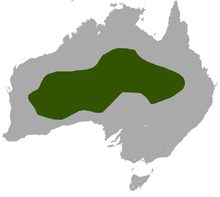Wongai-Ningaui
| Wongai-Ningaui | ||||||||||||
|---|---|---|---|---|---|---|---|---|---|---|---|---|
| Systematics | ||||||||||||
|
||||||||||||
| Scientific name | ||||||||||||
| Ningaui ridei | ||||||||||||
| Archer , 1975 |
The Wongai-Ningaui ( Ningaui ridei ), also called Rides Ningaui , is a very small member of the predator family . It occurs in the interior of Australia.
features
The Wongai-Ningaui reaches a head-trunk length of 57 to 75 millimeters, a tail length of 59 to 71 millimeters and a weight of 6.5 to 10.5 grams. From Pilbara Ningaui ( Ningaui timealeyi ) it differs by the smaller (less than 1 mm long) and less clearly marked balls. Females of the Pilbara-Ningaui have only six teats, those of the Wongai-Ningaui have a maximum of eight. Outwardly , the Wongai-Ningaui cannot be distinguished from the southern Ningaui ( Ningaui yvonneae ) which occurs further south . It has larger timpani than southern Ningaui.
Habitat and way of life
The Wongai-Ningaui lives in the deserts and semi-deserts of the Australian interior, which with spiked head grasses , shrubs such as Acacia ligulata , Grevillea eriostachya , maisonneuvei Thryptomene and Eucalyptus youngiana and trees such as the Mulga ( Acacia aneura ), Acacia cambagei , allocasuarina decaisneana , Hakea lorea and Ornamental cypresses ( Callitris ) are passed. Usually the annual rainfall is less than 350 mm, but in Queensland the range is up to 500 mm isohyete . Wongai-Ningaui does not occur in regions that the monsoons reach, such as the Pilbara region in the north of Western Australia. Nothing is known about the diet of the Wongai-Ningaui. The other two species in the genus feed primarily on invertebrates. The Wongai-Ningaui is nocturnal and spends the day in dense bushes, in natural cavities or in earthworks that have been dug by other animals such as lizards or large spiders. Wongai-Ningaui rarely dig a hole in the ground themselves. The females have six to eight teats and have five to eight young animals per litter.
Danger
The IUCN classifies the Wongai-Ningaui as Least Concern . It is widespread, common, and found in several protected areas.
Individual evidence
- ↑ a b c Andrew Baker: Family Dasyuridae (Carnivorous Marsupials). P. 330 and 331 in Don E. Wilson , Russell A. Mittermeier : Handbook of the Mammals of the World - Volume 5. Monotremes and Marsupials. Lynx Editions, 2015, ISBN 978-84-96553-99-6
- ↑ Ningaui yvonneae in the Red List of Threatened Species of the IUCN 2016. Posted by: Lellis, M., Menkhorst, P., van Weenen, J. & Burbidge, A., 2015. Accessed June 19, 2018th
